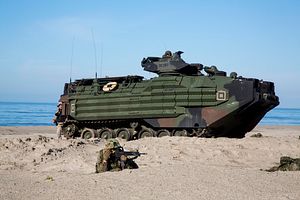On March 27, 2018, the Japan Ground Self-Defense Force (JGSDF) underwent its most significant structural reform since its formation in 1954 with the creation of a unified command and the launch of an Amphibious Rapid Deployment Brigade (ARDB) tasked with defending Japan’s remote islands. However, manufacturing delays and local opposition to stationing the V-22 Osprey will cause major setbacks to the new amphibious capability becoming operational.
Unlike the air and maritime services, the JGSDF has had no central headquarters to control its units. The JGSDF troops have been overseen by five regional armies operated under their respective commanding generals.
The move by the Ministry of Defense (MOD) will place the JGSDF unified command under the Ground Component Command in order to better respond to overarching regional threats to national security. Noting the lessons of power expansion by the Japanese Imperial Army, Defense Minister Itsunori Onodera asserted that civilian control over the military would be maintained appropriately “based on pre-war lessons.”
The ARDB — Japan’s version of the U.S. Marine Corps — was also created to respond to China’s maritime assertiveness. The ARDB will also come under the new Ground Component Command. In a press conference, Minister Onodera explained that the brigade would have amphibious operational capabilities to respond to potential attacks on remote islands.
The ARDB will be tasked with a landing operation to retake a territory when a foreign armed force occupies a Japanese island. It will be headquartered in the SDF’s Camp Ainoura in Sasebo, Nagasaki Prefecture, with the initial staffing level at 2,100 personnel. The Camp is known to focus on Japan’s South Western islands including the Senkaku Islands.
The brigade had planned to utilize vehicles such as the AAV7 and V-22 Osprey that are also used by the U.S. to transport personnel and supplies; however, reports have found that the MOD is facing some delays.
First, only 15 out of 52 AAV7 vehicles are stationed at the base due to manufacturing delays. Second, with numerous recent accidents of helicopters and V-22 Osprey in Japan, the initial plan to station the Osprey at Saga Airport has received pushback from local residents and is expected to be stationed in Chiba Prefecture more than 1,000 km away. This will likely cause the brigade to have decreased efficiency in its operational readiness and mobility.
Initially approved under the MOD’s medium-term defense buildup plan in 2013, this decision comes with the increasing concern over Chinese maritime activity in recent years and the Senkaku Islands which China also claims as its territory. According to the Government of Japan, in setting up an amphibious unit and bolstering readiness to dispatch troops, Japan will be able to enhance its deterrence against potential enemy attacks.
Critics say that this move could increase tension in neighboring countries and trigger an arms race falling into the Thucydides trap. Others argue that having a unit capable of conducting landing operations will go beyond the defense-oriented policy set forth since the end of WWII. On the other hand, the new brigade will also be able to better respond to a natural disaster.
During the 2011 earthquake and tsunami, the Japanese SDF lacked the amphibious capability to respond to the emergency quickly. Because of this, Japan had to rely heavily on the U.S. Tomodachi Operation for support. With the increasing need to better prepare itself for responding to a crisis, these efforts by the MOD make sense. However, various setbacks will make it difficult to fully make use of the amphibious capability.
John Taishu Pitt (@YJTPitt) is a recent MA graduate from American University where he focused on security and trade relations in East Asia. He currently works as a trade policy specialist at a law firm in Washington D.C.

































